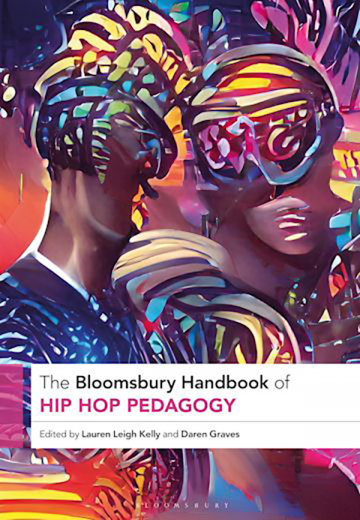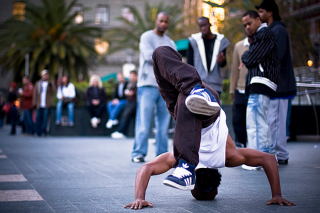Born in the 1970s, Graves remembers the early, pre-mainstream Hip Hop artists who shaped the art form. “When you heard their music on the radio, it caught your ear. It was so new and unique, and even as a child it drew me in.” When the art form emerged in the 1970s, Black and brown people were labeled as lawless, dangerous, and predatorial. These youths created something new and inspiring, even though they had no resources. “Hip Hop aligned itself with subversion and a politics of resistance. And since then it has really become a culture that has spanned the entire globe,” says Graves. “In fact, I would argue that Hip Hop is the most powerful cultural phenomenon that ever came out of the United States.”
Graves underscores that Hip Hop is fluid and multifaceted, and identifies five key elements that constitute the art form:
- emceeing (i.e., rapping)
- dance or body movement (e.g., breakdancing, b-boying, b-girling)
- DJing (i.e., curating and mixing music)
- graffiti/visual arts (see, for instance, the Museum of Fine Arts’ recent “Writing the Future” exhibition)
- a knowledge of self.
“This fifth element was very important to the founders of Hip Hop — many of whom were Black, Puerto Rican, Latinx, female and/or queer,” notes Graves. Hip Hop supposedly began at a 1973 dance party in the Bronx, in which young people with few resources enacted art-making by hacking spaces (i.e., repurposing an abandoned building) and remixing technologies (i.e., turntables). “By asserting their voices and bodies in these spaces, early Hip Hop artists were pushing back against the predominant ‘we’ve made it’ narratives of the immediate post-Civil Rights Movement era. Clearly, Hip Hop showed us that the United States was in no way a post-racial society,” explains Graves.
As an academic researcher, Graves is drawn to the truth-telling and consciousness-raising texture of the art form. At conferences hosted by the American Educational Research Association (AERA), Graves met several cutting-edge Hip Hop scholars. Along with Associate Professor of Education Lauren Leigh Kelly (Rutgers University), Graves was asked to co-chair AERA’s special interest group entitled “Hip Hop Theories, Praxis, and Pedagogies.” This community of researchers, educators, and practitioners generated fruitful discussions on how to utilize Hip Hop for the education and empowerment of youth culture.

One of the more significant accomplishments coming out of the special interest group is The Bloomsbury Handbook of Hip Hop Pedagogy (forthcoming, January 2024), co-edited by Graves and Kelly. (The two scholars, along with Sherell A. McArthur, previously co-curated and co-edited a special issue for the International Journal of Critical Media Literacy entitled “Teaching for Critical Consciousness: Critical Hip-Hop Pedagogy”). “Dr. Kelly and I wanted to showcase authentic and rigorous Hip Hop pedagogy in our Bloomsbury Handbook. We are not just imploring people to rap their lessons. Rather, we urge them to embrace the consciousness-raising awareness of Hip Hop in the classroom. This way, schools and educators can better support underserved youth and attempt to understand the individuals we are educating on their own terms,” says Graves.
As Graves and Kelly explain in their introduction to The Bloomsbury Handbook of Hip Hop Education, they embrace “critical pedagogy” as a key methodology. This concept originated with the Brazilian educator and philosopher Paolo Freire (1921–1997), who worked with rural communities that suffered from systemic oppression. Freire observed that their educational systems replicated patterns of inequality, and criticized what he called the “banking model,” in which the teacher has all the knowledge and capital while students are passive participants and empty vessels. By contrast, Freire championed the concept of critical pedagogy, which demands more reciprocity and interaction. In this way, educators acknowledge the prior knowledge of their students and build upon it, which troubles preexisting power relations in generative and productive ways.
“Pedagogy is the art and science of teaching, and being critical entails an explicit examination of power. Therefore, with critical pedagogy you are disrupting power during learning processes, and this promotes equity,” explains Graves. “In the book, we argue that Hip Hop, as a space for youth creativity and subversion, can operate as critical pedagogy.”
Indeed, as Graves and Kelly write in their introduction, engaging Hip Hop within otherwise formal schooling works to “dismantle structures of colonial power, oppression, and displacement and [can] transform our dreams into reality out of both necessity and resistance.” Thus, the book serves as a guide for “drawing upon our cultural past while developing radical new practices in the present to co-create a shared future rooted in love and possibility.”
For Graves, another important concept that overlaps with Hip Hop education is “achievement as resistance.” When students — and particularly BIPOC students — sense that a school is not made for them, they often resist by acting out. But by reconstruing resistance as a form of achievement, marginalized individuals can defy the deficit narrative imposed upon African Americans. “Making our way out of no way makes me think about the radical potential of Hip Hop education,” says Graves. “Moreover, Hip Hop contributes to empowering one’s racial identity development, and evidence suggests that students with positive racial identities perform better in school.”
Beyond the discipline of Education, Graves believes that Hip Hop can help transform and democratize higher learning. “The Academy has many rules and is a very privileged, stodgy, and formal space. Hip Hop, however, is always bending the rules. Many experts on Hip Hop do not have doctoral degrees or academic publications,” says Graves. The Bloomsbury Handbook, therefore, deliberately combines academic prose with creative written genres, including memoir, narrative, and interludes. “When curating this collection, my co-editor and I tried to be very inclusive. We welcome traditional scholars and non-traditional practitioners alike, and we want the Academy to follow suit.”
While Graves hopes that his forthcoming book will be a key resource for scholars and educators, he acknowledges the limits of academic publishing, which is often expensive and inaccessible to a general audience. Accordingly, Graves and his colleagues are creating a podcast series that will disseminate further the insights from the book. “The podcast series should get more traction and interaction with the community. It is really important for academics to make their findings accessible, and this way they will have a greater impact.”
To honor the 50th anniversary of Hip Hop, Graves urges people to acknowledge the resistance and resilience embedded in the art form from its inception. “I call Hip Hop ‘the beautiful struggle,’” says Graves. “It produces beauty out of poverty, discrimination, violence, and hardship. To me, Hip Hop is the quintessential American story. It’s the underdog story, it’s about coming from nowhere and making it everywhere.”
As we pay tribute to Hip Hop’s extraordinary impact on our world over the last half century, Graves advises that we should be proud of the artistic, social, and intellectual contributions of Hip Hop culture, yet also realize that there is more work to be done. “We are standing on the shoulders of giants,” he says, “and we need to take on the responsibility of being shoulders for the folks coming after us.”

